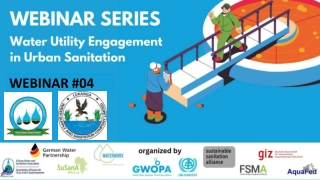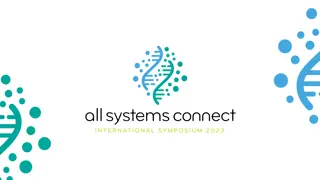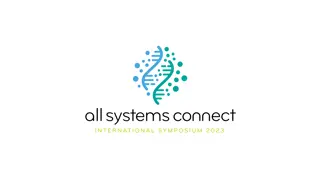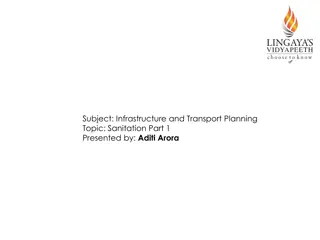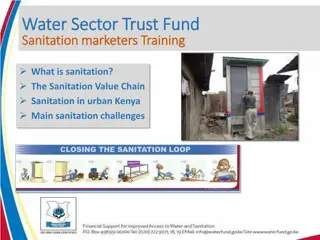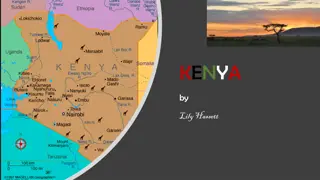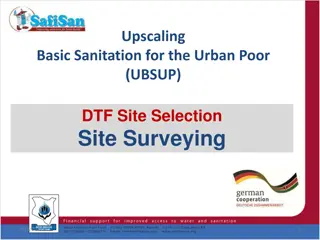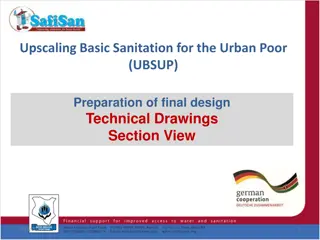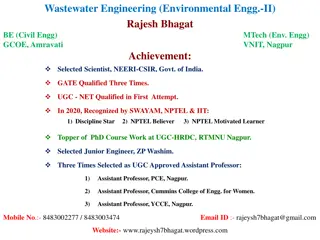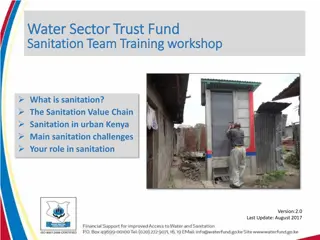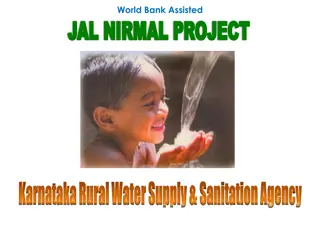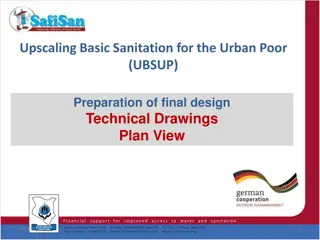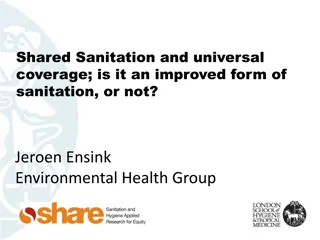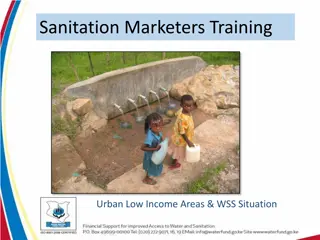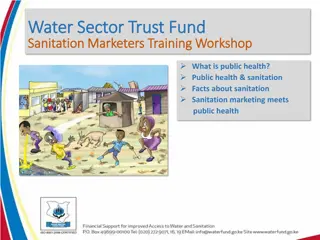Understanding New Urban Sanitation Technologies and Systems in Kenya
Explore the comprehensive training sessions and innovative technologies introduced for water sector reform in Kenya, focusing on urban sanitation systems. Gain insights into wastewater management, functional groups, sanitation value chain, and user interface, essential for sustainable sanitation solutions.
Download Presentation

Please find below an Image/Link to download the presentation.
The content on the website is provided AS IS for your information and personal use only. It may not be sold, licensed, or shared on other websites without obtaining consent from the author. Download presentation by click this link. If you encounter any issues during the download, it is possible that the publisher has removed the file from their server.
E N D
Presentation Transcript
Water Sector Reform in Kenya Trainings 24.-28.8. and 28.9.-2.10.2015 New Urban Sanitation Technologies
New Urban Sanitation Technologies Based on New Urban Sanitation Technologies e-learning course of Margraf Publishers New Urban Sanitation Technologies
Table of Content What is wastewater Functional groups User Interface Collection and Storage/Treatment Conveyance (Semi-) Centralized treatment Use and/or Disposal System templates New Urban Sanitation Technologies
Sanitation systems, a systematic view We define sanitation as a multi-step process in which human excreta and wastewater are managed from the point of generation to the point of use or ultimate disposal. A Sanitation System Sanitation System is a context-specific series of technologies and services for the management of these wastes (or resources), i.e., for their collection, containment, transport, transformation, utilization or disposal. A sanitation system is comprised of Products (wastes) that travel through Functional Groups Functional Groups which contain Technologies that can be selected according to the context. U S C T D New Urban Sanitation Technologies
U S C T D User Interface Disposal / Re-use Treatment Conveyance Collection/Storage Sanitation Value Chain New Urban Sanitation Technologies
Functional Groups A Functional Group is a grouping of technologies which perform a similar function. There are five (5) different Functional Groups from which the technologies used to build a system are chosen. The five (5) Functional Groups are: User Interface (Technologies U1 U6): Red Collection and Storage/Treatment (Technologies (S1 S12): Yellow Conveyance (Technologies C1 C7): Orange (Semi-) Centralized Treatment (Technologies T1 T17): Green Use and/or Disposal (Technologies D1 D12): Blue New Urban Sanitation Technologies
Functional Groups U S C T D Collection/Storage/(T ) User Interface Disposal / Re-use Treatment Conveyance S1 to S12 Technologies that collect and store the products generated C1 to C7 describes the transport of products from one FG to another T1 to T17 treatment technologies appropriate for large user groups) D1 to D13 Different technologies, products are returned to the environment U1 to U6 Technologies with which the user interacts New Urban Sanitation Technologies
User Interface User Interface (U) describes the type of toilet, pedestal, pan, or urinal with which the user comes in contact; it is the way by which the user accesses the sanitation system. In many cases, the choice of User Interface will depend on the availability of water. Note that Greywater and Stormwater do not originate at the User Interface, but may be treated along with the products that originate from it. New Urban Sanitation Technologies
User Interface New Urban Sanitation Technologies
User Interface is the way in which the sanitation system is accessed: U.01: Dry Toilet U.02: Urine-Diverting Dry Toilet (UDDT) U.03: Urinal U.04: Pour Flush Toilet U.05: Cistern Flush Toilet U.06: Urine-Diverting Flush Toilet (UDFT) New Urban Sanitation Technologies
Collection and Storage/Treatment (S) Collection and Storage/Treatment (S) describes the ways of collecting, storing, and sometimes treating the products generated at the User Interface. The treatment provided by these technologies is often a function of storage and is usually passive (e.g., requiring no energy input). Thus, products that are treated by these technologies often require subsequent treatment before Use and/or Disposal. New Urban Sanitation Technologies
Collection and Storage/Treatment (S) New Urban Sanitation Technologies
Collection and Storage/Treatment (S) describes the technologies that collect and store the products generated at the User Interface: S.01: Urine Storage Tank/Container S.02: Single Pit S.03: Single Ventilated Improved Pit (VIP) S.04: Double Ventilated Improved Pit (VIP) S.05: Fossa Alterna S.06: Twin Pits for Pour Flush S.07: Dehydration Vaults S.08: Composting Chamber S.09: Septic Tank S.10: Anaerobic Baffled Reactor (ABR) S.11: Anaerobic Filter S.12: Biogas Reactor New Urban Sanitation Technologies
Conveyance (C) Conveyance (C) describes the transport of products from one functional group to another. Although products may need to be transferred in various ways between functional groups, the longest, and most important gap is between User Interface or Collection and Storage/Treatment and (Semi-) Centralized Treatment. Therefore, for the sake of simplicity, Conveyance only describes the technologies used to transport products between these functional groups. New Urban Sanitation Technologies
Conveyance (C) New Urban Sanitation Technologies
Conveyance (C) C.01: Jerrycan/Tank C.02: Human-Powered Emptying and Transport C.03: Motorized Emptying and Transport C.04: Simplified Sewer C.05: Solids-Free Sewer C.06: Conventional Gravity Sewer C.07: Transfer Station (Underground Holding Tank) New Urban Sanitation Technologies
(Semi-) Centralized Treatment (Semi-) Centralized Treatment (T) refers to treatment technologies that are generally appropriate for large user groups (i.e., neighbourhood to city level applications). The operation, maintenance, and energy requirements of technologies within this functional group are generally higher than for smaller-scale technologies at the S level. The technologies are divided into 2 groups: T.1-T.12 are primarily for the treatment of Blackwater, Brownwater, Greywater or Effluent, whereas T.13-T.17 are mainly for the treatment of Sludge. New Urban Sanitation Technologies
(Semi-) Centralized Treatment New Urban Sanitation Technologies
(Semi-) Centralized Treatment, the treatment technologies generally appropriate for larger groups: Here the Technologies for the treatment of Blackwater, Brownwater, Greywater or Effluent: T.01: Settler T.02: Imhoff Tank T.03: Anaerobic Baffled Reactor (ABR) T.04: Anaerobic Filter T.05: Waste Stabilization Ponds (WSP) T.06: Aerated Pond T.07: Free-Water Surface Constructed Wetland T.08: Horizontal Subsurface Flow Constructed Wetland T.09: Vertical Flow Constructed Wetland T.10: Trickling Filter T.11: Upflow Anaerobic Sludge Blanket Reactor (UASB) T.12: Activated Sludge New Urban Sanitation Technologies
(Semi-) Centralized Treatment, the treatment technologies generally appropriate for larger groups: Here the Technologies for the treatment of sludge: T.13: Sedimentation/Thickening Ponds T.14: Unplanted Drying Beds T.15: Planted Drying Beds T.16: Co-Composting T.17: Biogas Reactor New Urban Sanitation Technologies
Use and/or Disposal Use and/or Disposal (D) refers to the methods by which products are ultimately returned to the environment, either as useful resources or reduced-risk materials. Furthermore, products can also be cycled back into a system (e.g., by using treated Greywater for flushing). New Urban Sanitation Technologies
Use and/or Disposal New Urban Sanitation Technologies
Use and/or Disposal refers to the methods by which products are ultimately returned to the environment: D.01: Fill and Cover/Arborloo D.02: Application of Stored Urine D.03: Application of Dehydrated Faeces D.04: Application of Pit Humus and Compost D.05: Application of Sludge D.06: Irrigation D.07: Soak Pit D.08: Leach Field D.09: Fish Pond D.10: Floating Plant Pond D.11: Water Disposal/Groundwater Recharge D.12: Surface Disposal and Storage D.13: Biogas Combustion New Urban Sanitation Technologies
Different columns of a system template New Urban Sanitation Technologies
Biogas System as an example New Urban Sanitation Technologies



